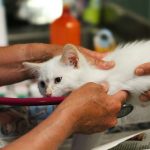Shelter life can be stressful for cats, impacting their well-being and behavior. By focusing on environmental enrichment, shelters can create a more stimulating, comforting space that alleviates anxiety. Strategies like interactive play, sensory stimuli, and safe hiding spots foster natural behaviors, allowing cats to feel secure. Explore proven techniques to enhance shelter life, ultimately improving the chances of adoption and fostering happier, healthier felines.
Understanding Environmental Enrichment for Cats
Environmental enrichment is a crucial concept in enhancing the quality of life for cats, particularly those in shelter environments. It refers to the process of improving the living conditions and surroundings of cats to stimulate their natural behaviors and mental well-being. This practice is essential for promoting healthy feline behavior and ensuring stress reduction.
A lire aussi : Spotting Hyperthyroidism in Cats: Key Symptoms and Effective Treatment Solutions
Cats, like many animals, can experience significant stress, especially when confined to shelters. Stress in cats often manifests through behaviors such as excessive grooming, aggression, or withdrawal. The impact of such stress is not only detrimental to their psychological well-being but can also affect their physical health, making them more susceptible to illnesses.
Environmental enrichment plays a pivotal role in mitigating these stressors. By providing cats with opportunities to engage in natural activities such as climbing, scratching, and hunting, we can significantly enhance their mental state. This can be achieved through various means such as interactive toys, climbing structures, and spaces that allow for exploration and play.
Cela peut vous intéresser : Transforming Your Cat”s Nocturnal Habits: Effective Strategies for Coordinating Their Schedule with Yours
Moreover, the psychological benefits of enrichment extend beyond stress reduction. Enriched environments can lead to more sociable and adaptable cats, making them more likely to be adopted. By understanding and implementing environmental enrichment, we can improve the lives of shelter cats and support their overall well-being.
Proven Strategies for Environmental Enrichment
Implementing effective enrichment strategies is vital for enhancing the well-being of shelter cats. These strategies involve a variety of activities aimed at promoting cat welfare and stimulating natural behaviors.
Types of Environmental Enrichment
Understanding the different types of environmental enrichment is crucial for creating a balanced environment. Physical enrichment tools like climbing structures and interactive toys are essential to encourage movement and play. These tools allow cats to exercise, which is vital for their physical health and mental stimulation.
Sensory enrichment involves engaging a cat’s senses through scents, sounds, and textures. Introducing new smells or auditory stimuli can keep a cat’s environment intriguing and prevent boredom. Textured surfaces or different materials can also provide tactile stimulation, contributing to a cat’s overall sensory experience.
Social enrichment focuses on interaction with humans and other animals. Regular interaction with shelter staff and other cats can improve a cat’s social skills and adaptability. This type of enrichment is particularly beneficial for cats that may be shy or withdrawn, helping them become more sociable and increasing their chances of adoption.
By integrating these diverse enrichment strategies, shelters can significantly improve the quality of life for their feline residents, ensuring they remain healthy and engaged.
Psychological and Physical Benefits of Enrichment
Understanding the psychological and physical benefits of environmental enrichment is fundamental for improving cat welfare. Enrichment plays a crucial role in reducing anxiety and stress-related behaviors in cats, fostering more positive cat behavior benefits. When cats are provided with opportunities for mental stimulation, they exhibit fewer stress-induced behaviors such as excessive grooming or aggression. This mental engagement is essential for their psychological well-being, helping them feel more secure and content in their environment.
Moreover, enrichment activities significantly enhance a cat’s physical health. Engaging in physical activities like climbing and playing not only keeps cats physically fit but also helps prevent obesity-related health issues. Regular exercise is vital for maintaining a healthy weight and supporting overall bodily functions.
The long-term benefits of a stimulating environment extend beyond immediate health improvements. Cats in enriched environments often become more adaptable and resilient, which can lead to increased chances of successful adoption. A well-stimulated cat is typically more sociable and exhibits a balanced temperament, making them more appealing to potential adopters. By prioritizing both psychological and physical enrichment, shelters can ensure that their feline residents thrive, leading healthier and happier lives.
Case Studies and Success Stories
Exploring case studies of successful implementation of enrichment strategies in shelters provides valuable insights into their effectiveness. Many shelters have adopted diverse enrichment techniques, leading to notable improvements in feline well-being.
One such shelter success story comes from a facility that introduced comprehensive environmental enrichment programs. The staff incorporated climbing structures, interactive toys, and sensory stimuli to engage the cats’ natural instincts. Post-implementation, the shelter observed a remarkable reduction in stress-related behaviors, such as aggression and excessive grooming. Cats became more sociable and exhibited healthier interactions with both humans and fellow felines.
Shelter staff and volunteers have shared positive testimonials about these changes. One volunteer noted, “The difference in the cats’ demeanor is incredible. They seem happier and more relaxed.” Another staff member highlighted the increased adoption rates, stating, “Potential adopters are drawn to the cats’ playful and friendly nature, which has significantly boosted our adoption numbers.”
These case studies underscore the transformative impact of environmental enrichment. By implementing tailored enrichment strategies, shelters not only enhance the lives of their feline residents but also increase their chances of finding forever homes. This approach fosters a more harmonious shelter environment, benefiting both cats and caregivers alike.
Practical Implementation Tips for Shelters
Implementing effective enrichment strategies within shelters requires thoughtful planning and execution. Key considerations include establishing comprehensive shelter protocols that ensure consistency and effectiveness. These protocols should outline the types of enrichment activities suitable for various feline personalities and needs.
Training is crucial. Staff and volunteers must be well-versed in enrichment implementation techniques. Regular workshops or training sessions can equip them with the necessary skills to engage cats properly. This training should cover the use of tools, such as interactive toys and climbing structures, and the importance of sensory enrichment.
Monitoring and evaluating the effectiveness of enrichment programs is essential. Regular assessments allow shelters to adjust strategies based on observed outcomes. This can involve tracking changes in cat behavior, health, and adoption rates. Best practices suggest using feedback from both staff and adopters to refine approaches continually.
By focusing on these areas, shelters can enhance their enrichment implementation efforts. This not only improves the quality of life for cats but also fosters a more efficient and harmonious environment. Consistent evaluation and adaptation of strategies ensure that enrichment remains effective and beneficial for all feline residents.
Resources and Further Reading
To deepen your understanding of feline behavior and enrichment guides, several resources can be invaluable. Recommended books such as “The Trainable Cat” by John Bradshaw and Sarah Ellis offer insights into training and understanding cat behavior, making them essential reads for any cat enthusiast. Another notable work is “Catification” by Jackson Galaxy and Kate Benjamin, which provides creative ideas for designing cat-friendly spaces.
For those seeking online resources, websites like the ASPCA and International Cat Care offer comprehensive enrichment guides and practical tips for enhancing your cat’s environment. These platforms provide a wealth of information on enrichment tools and activities that cater to various feline needs.
Organizations dedicated to animal welfare, such as the Humane Society and Best Friends Animal Society, focus on promoting cat welfare and offer numerous resources. These organizations provide guidelines and support for implementing effective enrichment practices in shelters and homes.
By exploring these resources, you can gain a deeper understanding of feline behavior and discover innovative ways to enrich your cat’s life, ultimately contributing to their overall well-being.
















